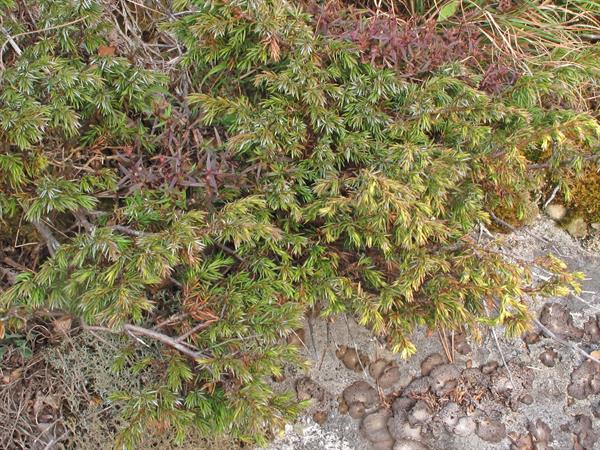
Origin/Endemic status: Native
Taxonomy Comments: Var. depressa, a decumbent shrub, up to about 1 meter high, forms large clonal patches. Harvill et al. (1992) reported scattered sites for var. communis in montane VA; these are based on columnar trees. Adams in FNA (1993b) considered var. depressa to be the only variety occurring in e. United States, and stated that var. depressa sometimes forms columnar trees to 10 m tall; Adams et al. (2016) accepted var. communis from our area. Additional problems about the status of Juniperus communis in our area remain unresolved; variation in growth form, morphologic characters, and habitat suggest the possibility of the presence of several native taxa. See Coker & Totten (1945) for additional discussion.
Other Comments: The "berry" of Juniperus communis s.l. is the juniper berry used as a spice, as well as the main flavoring of gin.
Synonymy: = C, F, FNA2, G, Il, K1, K3, K4, Mi, NE, NY, Pa, RAB, Va, W, Adams (2008b), Adams (2014), Adams (2018), Adams et al (2016); = Juniperus canadensis Lodd. ex Burgsd.; = Juniperus sibirica Burgsd. – S, S13, misapplied; < Juniperus communis L. – GrPl, Tat, WV
Wetland Indicator Status:
- Atlantic and Gulf Coastal Plain: FACU (name change)
- Eastern Mountains and Piedmont: FACU (taxonomic split from wetland indicator species)
- Great Plains: UPL (taxonomic split from wetland indicator species)
- Midwest: UPL (taxonomic split from wetland indicator species)
- Northcentral & Northeast: FACU (taxonomic split from wetland indicator species)
Heliophily: 7
Hover over a shape, letter, icon, or arrow on the map for definition or see the legend.
 © Alan Cressler: Juniperus communis var. depressa, berries, Broad River area, Madison County, Georgia 1 by Alan Cressler source | Original Image ⭷
© Alan Cressler: Juniperus communis var. depressa, berries, Broad River area, Madison County, Georgia 1 by Alan Cressler source | Original Image ⭷ © Alan Cressler: Juniperus communis var. depressa, female cones, Broad River area, Madison County, Georgia 2 by Alan Cressler source | Original Image ⭷
© Alan Cressler: Juniperus communis var. depressa, female cones, Broad River area, Madison County, Georgia 2 by Alan Cressler source | Original Image ⭷ © Alan M. Cressler | Original Image ⭷
© Alan M. Cressler | Original Image ⭷ © Alan Cressler: Juniperus communis var. depressa, male cones, Broad River area, Madison County, Georgia 1 by Alan Cressler source | Original Image ⭷
© Alan Cressler: Juniperus communis var. depressa, male cones, Broad River area, Madison County, Georgia 1 by Alan Cressler source | Original Image ⭷ © Alan M. Cressler | Original Image ⭷
© Alan M. Cressler | Original Image ⭷ © Alan M. Cressler | Original Image ⭷
© Alan M. Cressler | Original Image ⭷ © Erik Danielson source | Original Image ⭷
© Erik Danielson source | Original Image ⭷ © Alan M. Cressler | Original Image ⭷
© Alan M. Cressler | Original Image ⭷ © Bruce A. Sorrie | Original Image ⭷
© Bruce A. Sorrie | Original Image ⭷ © Alan Cressler: Juniperus communis var. depressa, Satulah Mountain, Highlands-Cashiers Land Trust, Macon County, North Carolina 1 by Alan Cressler source | Original Image ⭷
© Alan Cressler: Juniperus communis var. depressa, Satulah Mountain, Highlands-Cashiers Land Trust, Macon County, North Carolina 1 by Alan Cressler source | Original Image ⭷ © Erik Danielson source | Original Image ⭷
© Erik Danielson source | Original Image ⭷Feedback
See something wrong or missing on about Juniperus communis var. depressa? Let us know here: (Please include your name and email if at all complicated so we can clarify if needed.)
Cite as...